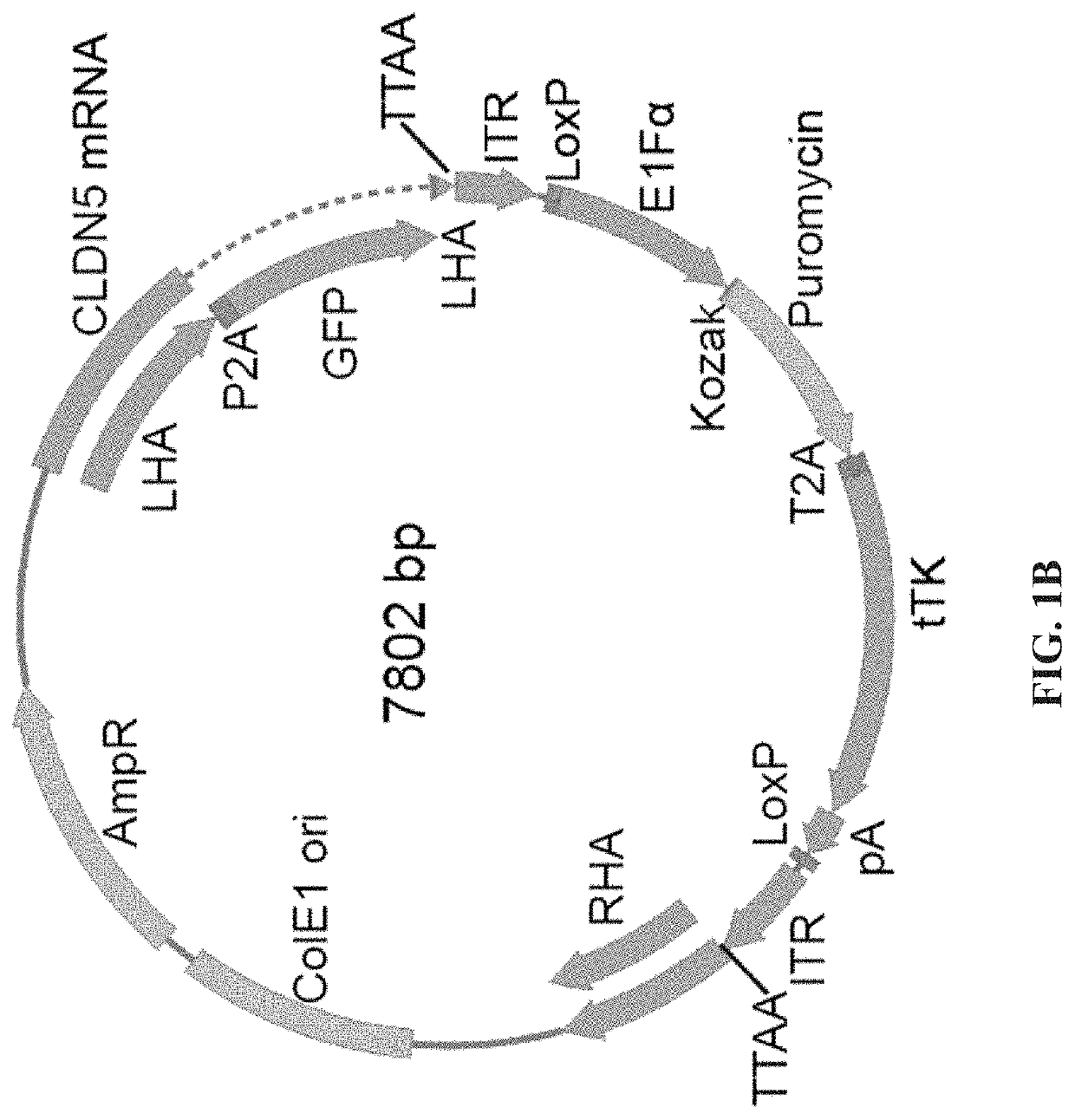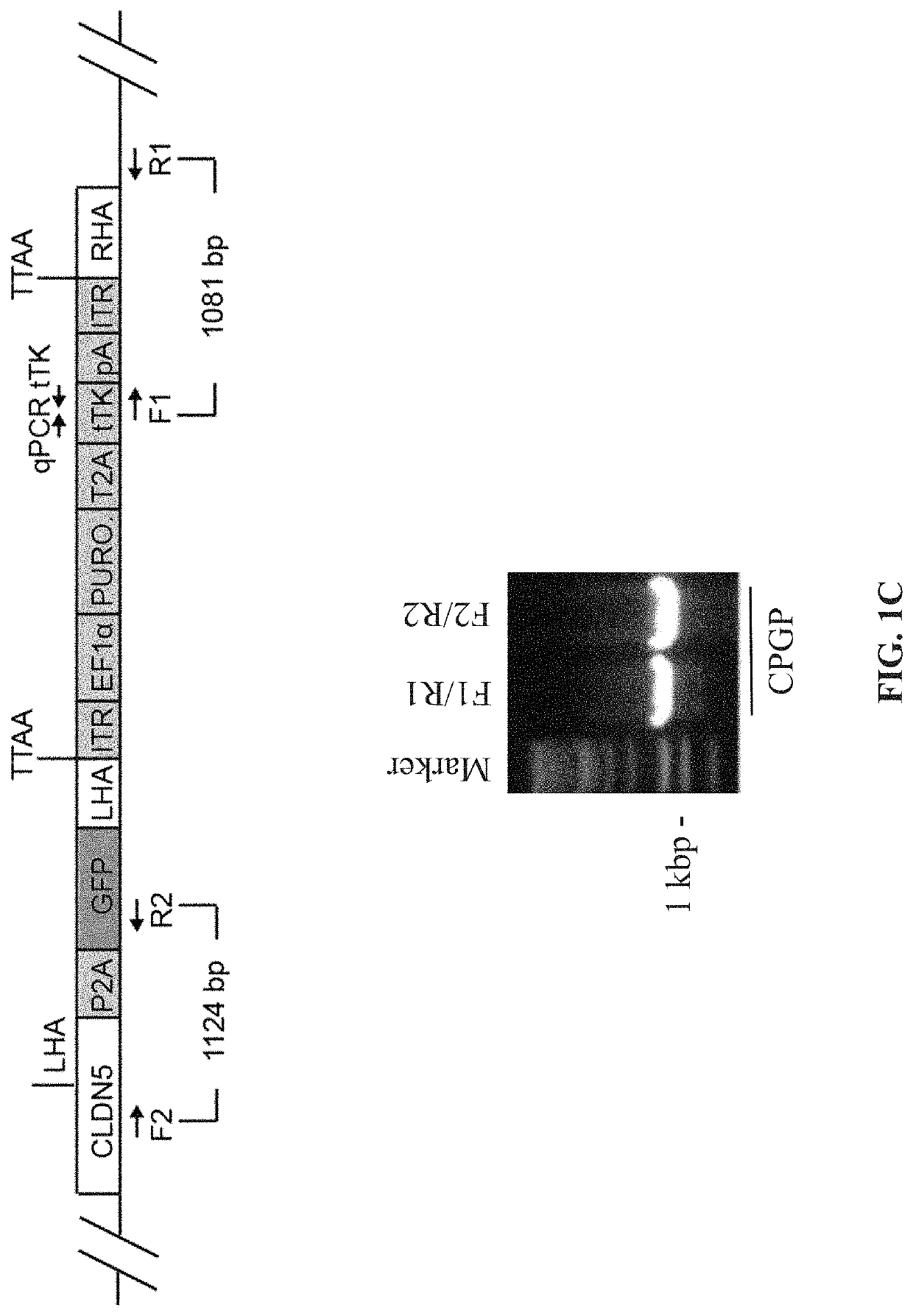Methods for assessing transendothelial barrier integrity
- Summary
- Abstract
- Description
- Claims
- Application Information
AI Technical Summary
Benefits of technology
Problems solved by technology
Method used
Image
Examples
example 1
[0180]Genome Editing of the CLDN5 Transcriptional Reporter in hPSCs.
[0181]To evaluate the barrier properties of endothelial cells with a surrogate marker CLDN5 was tagged at the 3′ end with P2A self-cleaving peptide and GFP (FIG. 1A). We have designed the sgRNA in the vicinity of stop codon of CLDN5 while a donor plasmid (FIG. 1B) was generated to carry a promoterless P2A-GFP sequence flanked by two homology arms (HAs) at each end with piggyBac inverted terminal repeats (ITR) that allow traceless excision of the resistance cassettes. The double stranded break made by Cas9 and sgRNA was repaired by homologous recombination between CLDN5 and donor template (FIG. 1C) and subsequently resistance cassette was removed by excision only piggybac transposase (FIG. 1D). Single cell clones were picked and expanded.
[0182]We have evaluated lack of tTK by qPCR (not shown) and identified several clones lacking tTK. These clones were evaluated in gel PCR for correct insertion and orientation of GFP...
example 2
[0183]Generation and characterization of Stem-cell derived endothelial cells CLDN5 reporter. Using a previously published protocol (Patsch C, Challet-Meylan L, Thoma E C, Urich E, Heckel T, O'Sullivan J F, et al. Nature cell biology. 2015; 17(8):994-1003.) human pluripotent stem-cell line reporter line and WT line were differentiated to endothelial cells and 15-25% (FIG. 2A, depending on clone, data shown for one clone) of GFP+ cells and no GFP+ cells in WT line were observed. The GFP+ and GFP− cells were FACS-sorted and Electric Cell-substrate Impedance Sensing measurement was performed. An 1.75 fold increase of barrier resistance was observed in GFP+ cells (Resistance of 3200Ω, FIG. 2B). Next, RNA-sequencing and TMT mass proteomics was performed (not shown) on both GFP+ and GFP− FACS sorted cells and a very good correlation between significantly changed proteins and corresponding mRNAs was observed (r=0.79, p<0.0001, FIG. 2C). Significant upregulation of CLDN5 on mRNA and protein ...
example 3
[0184]CLDN5-GFP+ ECs show functional response of high transendothelial barrier integrity. Next, gene-set enrichment analysis was performed (GSEA, Subramanian A, Tamayo P, Mootha V K, Mukherjee S, Ebert B L, Gillette M A, et al. Proceedings of the National Academy of Sciences of the United States of America. 2005; 102(43):15545-50.) with the Hallmarks MsigDB (Liberzon A, Birger C, Thorvaldsdottir H, Ghandi M, Mesirov J P, Tamayo P. Cell systems. 2015; 1(6):417-25.) database using the ranked list of a product of the log 2FC and the −log 10FDR of the comparison of GFP+ and GFP− sorted cells (data not shown). Interestingly, enrichment of angiogenesis, TGFß and E2F proliferation pathway was found among downregulated genes and enrichment in WNT signaling in upregulated gens (data not shown). The pathway enrichment analysis (Zhou Y, Wang Y, Tischfield M, Williams J, Smallwood P M, Rattner A, et al. The Journal of clinical investigation. 2014; 124(9):3825-46., Suzuki E, Nagata D, Yoshizumi ...
PUM
| Property | Measurement | Unit |
|---|---|---|
| Fraction | aaaaa | aaaaa |
| Fraction | aaaaa | aaaaa |
| Fraction | aaaaa | aaaaa |
Abstract
Description
Claims
Application Information
 Login to view more
Login to view more - R&D Engineer
- R&D Manager
- IP Professional
- Industry Leading Data Capabilities
- Powerful AI technology
- Patent DNA Extraction
Browse by: Latest US Patents, China's latest patents, Technical Efficacy Thesaurus, Application Domain, Technology Topic.
© 2024 PatSnap. All rights reserved.Legal|Privacy policy|Modern Slavery Act Transparency Statement|Sitemap



